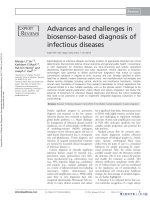Springer simulation approaches in transportation analysis recent advances and challenges 2005
Bạn đang xem bản rút gọn của tài liệu. Xem và tải ngay bản đầy đủ của tài liệu tại đây (14.43 MB, 412 trang )
SIMULATION APPROACHES IN
TRANSPORTATION ANALYSIS
Recent Advances and Challenges
OPERATIONS RESEARCH/COMPUTER SCIENCE
INTERFACES SERIES
Series Editors
Professor Ramesh Sharda
Oklahoma State University
Prof. Dr. Stefan Voß
Universität Hamburg
Other published titles in the series:
Greenberg /A Computer-Assisted Analysis System for Mathematical Programming Models and
Solutions: A User’s Guide for ANALYZE
Greenberg / Modeling by Object-Driven Linear Elemental Relations: A Users Guide for MODLER
Brown & Scherer / Intelligent Scheduling Systems
Nash & Sofer / The Impact of Emerging Technologies on Computer Science & Operations
Research
Barth / Logic-Based 0-1 Constraint Programming
Jones / Visualization and Optimization
Barr, Helgason & Kennington / Interfaces in Computer Science & Operations Research:
Advances in Metaheuristics, Optimization, & Stochastic Modeling Technologies
Ellacott, Mason & Anderson / Mathematics of Neural Networks: Models, Algorithms &
Applications
Woodruff /Advances in Computational & Stochastic Optimization, Logic Programming, and
Heuristic Search
Klein / Scheduling of Resource-Constrained Projects
Bierwirth / Adaptive Search and the Management of Logistics Systems
Laguna & González-Velarde / Computing Tools for Modeling, Optimization and Simulation
Stilman / Linguistic Geometry: From Search to Construction
Sakawa / Genetic Algorithms and Fuzzy Multiobjective Optimization
Ribeiro & Hansen / Essays and Surveys in Metaheuristics
Holsapple, Jacob & Rao / Business Modelling: Multidisciplinary Approaches — Economics,
Operational and Information Systems Perspectives
Sleezer, Wentling & Cude/Human Resource Development And Information Technology: Making
Global Connections
Voß & Woodruff / Optimization Software Class Libraries
Upadhyaya et al / Mobile Computing: Implementing Pervasive Information and Communications
Technologies
Reeves & Rowe / Genetic Algorithms—Principles and Perspectives: A Guide to GA Theory
Bhargava & Ye / Computational Modeling And Problem Solving In The Networked World:
Interfaces in Computer Science & Operations Research
Woodruff /Network Interdiction And Stochastic Integer Programming
Anandalingam & Raghavan / Telecommunications Network Design And Management
Laguna & Martí / Scatter Search: Methodology And Implementations In C
Gosavi/ Simulation-Based Optimization: Parametric Optimization Techniques and Reinforcement
Learning
Koutsoukis & Mitra / Decision Modelling And Information Systems: The Information Value Chain
Milano / Constraint And Integer Programming: Toward a Unified Methodology
Wilson & Nuzzolo / Schedule-Based Dynamic Transit Modeling: Theory and Applications
Golden, Raghavan & Wasil / The Next Wave In Computing, Optimization, And Decision
Technologies
Rego & Alidaee/ Metaheuristics Optimization Via Memory and Evolution: Tabu Search and
Scatter Search
SIMULATION APPROACHES IN
TRANSPORTATION ANALYSIS
Recent Advances and Challenges
edited by
Ryuichi Kitamura
Masao Kuwahara
Springer
eBook ISBN:
Print ISBN:
0-387-24109-4
0-387-24108-6
©2005 Springer Science + Business Media, Inc.
Print ©2005 Springer Science + Business Media, Inc.
Boston
All rights reserved
No part of this eBook may be reproduced or transmitted in any form or by any means, electronic,
mechanical, recording, or otherwise, without written consent from the Publisher
Created in the United States of America
Visit Springer's eBookstore at:
and the Springer Global Website Online at:
CONTENTS
PREFACE
Part I: Simulation Models and Their Application:
State of the Art
APPLICATION OF A SIMULATION-BASED DYNAMIC TRAFFIC
ASSIGNMENT MODEL
Michael Florian, Michael Mahut and Nicolas Tremblay
THE DRACULA DYNAMIC NETWORK MICROSIMULATION MODEL
Ronghui Liu
DYNAMIC NETWORK SIMULATION WITH AIMSUN
Jaime Barceló and Jordi Casas
MICROSCOPIC TRAFFIC SIMULATION: MODELS AND APPLICATION
Tomer Toledo, Haris Koutsopoulos, Moshe Ben-Akiva, and Mithilesh Jha
Part II: Applications of Transport Simulation
THE ART OF THE UTILIZATION OF TRAFFIC SIMULATION MODELS:
HOW DO WE MAKE THEM RELIABLE TOOLS?
Ryota Horiguchi and Masao Kuwahara
ABSORBING MARKOV PROCESS OD ESTIMATION AND A
TRANSPORTATION NETWORK SIMULATION MODEL
Jun-ichi Takayama and Shoichiro Nakayama
vi
SIMULATION APPROACHES IN TRANSPORTATION ANALYSIS
SIMULATING TRAVEL BEHAVIOUR USING LOCATION POSITIONING
DATA COLLECTED WITH A MOBILE PHONE SYSTEM
Yasuo Asakura, Eiji Hato and Katsutoshi Sugino
Part III: Representing Traffic Dynamics
SIMULATION OF THE AUTOBAHN TRAFFIC IN NORTH RHINEWESTPHALIA
Michael Schreckenberg, Andreas Pottmeier,
Roland Chrobok and Joachim Wahle
DATA AND PARKING SIMULATION MODELS
William Young and Tan Yan Weng
SAGA OF TRAFFIC SIMULATION MODELS IN JAPAN
Hirokazu Akahane, Takashi Oguchi and Hiroyuki Oneyama
A STUDY ON FEASIBILITY OF INTEGRATING PROBE VEHICLE DATA
INTO A TRAFFIC STATE ESTIMATION PROBLEM USING SIMULATED
DATA
Chumchoke Nanthawichit, Takashi Nakatsuji and Hironori Suzuki
Part IV: Representing User Behavior
CONSISTENCY OF TRAFFIC SIMULATION AND TRAVEL BEHAVIOUR
CHOICE THEORY
Noboru Harata
DRIVER’S ROUTE CHOICE BEHAVIOR AND ITS IMPLICATIONS ON
NETWORK SIMULATION AND TRAFFIC ASSIGNMENT
Takayuki Morikawa, Shinya Kurauchi, Toshiyuki Yamamoto, Tomio Miwa and
Kei Kobayashi
Contents
vii
AN OVERVIEW OF PCATS/DEBNETS MICRO-SIMULATION SYSTEM:
ITS DEVELOPMENT, EXTENSION, AND APPLICATION TO DEMAND
FORECASTING
Ryuichi Kitamura, Akira Kikuchi, Satoshi Fujii and Toshiyuki Yamamoto
This page intentionally left blank
SIMULATION APPROACHES IN
TRANSPORTATION ANALYSIS:
Recent Advances and Challenges
Ryuichi Kitamura and Masao Kuwahara
Preface
Achieving efficient, safe, and convenient urban automotive transportation has
been the primary concern of transportation planners, traffic engineers, and
operators of road networks. As the construction of new roadways becomes
increasingly difficult and, at the same time, as the adverse environmental
impacts of automotive traffic are more critically assessed, and as the depletion
of fossil fuels and global warming loom as serious problems, it is now
imperative that effective traffic control strategies, demand management
schemes and safety measures be expeditiously implemented.
The advent of advanced information and telecommunications technologies
and their application to transportation systems have expanded the range of
options available in managing and controlling network traffic. For example,
providing individualized real-time information to drivers is now almost reality.
Evolving Intelligent Transport Systems (ITS) technology is making it possible
to link the driver, vehicle and road system by exchanging information among
them, calling for the development of new traffic control strategies. It is in this
context that transport simulation is emerging as the key concept in traffic
control and demand management.
Motivated by this line of thought, the International Symposium on Transport
Simulation was held in Yokohama, Japan, in August 2002. It aimed at
providing a forum where groups of researchers who are engaged in
x
SIMULATION APPROACHES IN TRANSPORTATION ANALYSIS
cutting-edge research in transport simulation would gather from all over the
world, and exchange their results, discuss research issues, and identify future
directions of development. Specifically, it was envisaged that the Symposium
would contribute to the development and application of transport simulation
methods by
introducing
state-of-the-art
transport
simulation
models,
methodologies, and examples of their applications,
identifying short-term and long-term research issues,
assessing promising application areas for simulation, and
evaluating the applicability of transport simulation methods to other
research areas.
It was also hoped that this Symposium would aid in establishing a worldwide
network of researchers involved in transport simulation.
A total of 19 papers were presented at the Symposium. While some were
concerned with specific simulation model systems and their application (most
of the major simulation model systems available were represented at the
Symposium), others addressed various research issues in transport simulation.
This volume contains a set of papers selected from those presented at the
Symposium.
This book is divided into four parts. Part I comprises four papers that
represent simulation models for dynamic network assignment. The first paper
by Florian et al., which was the keynote speech at the Symposium, offers a
concise review of existing dynamic network simulation models and an
overview of issues involved in simulation-based dynamic traffic assignment.
A successful application example to a medium-size network is then presented.
The second paper by Liu presents the dynamic traffic network simulator,
DRACULA, whose unique features include the representation of day-to-day
variation in demand and drivers’ learning. The following paper by Barcelo
and Casas presents the microscopic traffic simulator, AIMSUN, describes car
following, lane changing and other elements of the model system, and
discusses its application to dynamic network simulation. The last paper of Part
I by Toledo et al. describes the microscopic traffic simulation tool,
MITSIMLab, detailing its representation of driver behavior, touching on
calibration and validation issues, and demonstrating a Stockholm, Sweden,
case study results.
Part II contains three papers that are concerned with the development and
application of transport simulation. The first paper by Horiguchi and
Preface
xi
Kuwahara assesses the status of simulation model application in Japan,
describes the ongoing effort toward standardized model verification and
validation, and report on the establishment of a forum for information
exchange in Japan. The second paper by Takayama and Nakayama discusses
the estimation of an origin-destination matrix in conjunction with network
simulation, where paths on the network are assumed to follow an absorbing
Markov chain process, whose parameters are estimated using genetic
algorithms. In the third paper by Asakura et al., mobile communications
technology is applied to acquire space-time trajectory data from cellular
phone holders, and the resultant data are applied to simulate how the
participants of a sports event disperse and travel toward their respective
destinations after the event is over.
Estimating and representing the dynamics of traffic flow and individual
vehicle movement is the common concern of the four papers in Part III. In the
first paper, Schreckenberg et al. attempt to combine, as “an online-tool,”
information from real-time traffic data from detectors and results of
microscopic traffic simulation to determine the state of traffic throughout the
German autobahn network. Young and Weng discuss issues involved in
simulating parking in urban area, addressing the microscopic representation of
vehicle movement in parking facilities, drivers’ decision making including
route choice, and the interaction among data collection, model accuracy and
model validity. The third paper by Akahane et al. offers a historical summary
and assessment of the development of traffic simulation models in Japan,
describing the evolution of the representation of vehicle dynamics, path
definition methodologies, and improvement in computational efficiency. In
the last paper of Part III, Nanthawichit et al. propose a methodology to
combine probe data and conventional detector data to estimate the state of
traffic on roadway segments with improved accuracy, through the application
of Kalman filters.
As its title suggests, Part IV is concerned with the representation of user
behavior. The first paper by Harata addresses the issue of consistency between
traffic simulation models and travel behavior choice theory, and examines
specifically dynamic route choice models and time-of-day choice models.
Following this, Morikawa et al. critically examine the traditional assumptions
of shortest-path choice and user equilibrium based on perfect information,
through network assignment with imperfect information. In the last paper of
the volume, Kitamura et al. present PCATS, a micro-simulator of individuals’
daily travel, which produces trip demand along a continuous time axis, and
illustrate its application to the analysis of TDM measures and to long-term
demand forecasting along with a dynamic network simulator, DEBNetS.
xii
SIMULATION APPROACHES IN TRANSPORTATION ANALYSIS
As these chapters demonstrate, transport simulation has become a powerful
tool in both research and practice. It can be a practical tool for the real-time
forecasting of future traffic status on road networks and evaluation of the
effectiveness of alternative traffic control measures. It can be applied in the
assessment of the effectiveness of alternative TDM measures, or in the
selection and implementation of a variety of ITS schemes now being
developed. It is hoped that this volume will aid in further development of
transport simulation models and their prevalent adoption as a practical tool in
traffic control and transportation planning.
A large number of individuals contributed to the organization of the
Symposium and the editing of this book. In particular, we note the efforts by
Drs. Akira Kikuchi, Hiroyuki Oneyama and Toshio Yoshii, who contributed
tremendously throughout this project. Special thanks go to Ms. Kiyoko
Morimoto; we owe the success of the Symposium to her bookkeeping and
management skills. We also thank the speakers, presenters at the demo
sessions, and the audience at the Symposium. Finally, we dedicate this book
to those researchers and practitioners whose endeavors are contributing to
better urban transportation in many significant ways.
APPLICATION OF A SIMULATION-BASED
DYNAMIC TRAFFIC ASSIGNMENT MODEL
Michael Florian, Michael Mahut and Nicolas Tremblay
INRO Consultants, Inc. 5160 Décarie Blvd., Suite 610,
Montreal, Quebec, H3X 2H9 Canada
(mike, michaelm, nicolas)@inro.ca
ABSTRACT
The evaluation of on-line intelligent transportation system (ITS) measures,
such as adaptive route-guidance and traffic management systems, depends
heavily on the use of faster than real time traffic simulation models. Off-line
applications, such as the testing of ITS strategies and planning studies, are
also best served by fast-running traffic models due to the repetitive or iterative
nature of such investigations. This paper describes a simulation-based,
iterative dynamic-equilibrium traffic assignment model. The determination of
time-dependent path flows is modeled as a master problem that is solved
using the method of successive averages (MSA). The determination of path
travel times for a given set of path flows is the network-loading sub-problem,
which is solved using the space-time queuing approach of Mahut. This
loading method has been shown to provide reasonably accurate results with
very little computational effort. The model was applied to the Stockholm road
network, which consists of 2100 links, 1,191 nodes, 228 zones, representing
and 4,964 turns. The results show that this model is applicable to medium-size
networks with a very reasonable computation time.
Keywords – dynamic traffic assignment, method of successive averages, traffic
simulation, queuing models
2
SIMULATION APPROACHES IN TRANSPORTATION ANALYSIS
INTRODUCTION
The functional requirements of a dynamic traffic assignment (DTA) model for
ITS applications may be subdivided into two major modes of use: off-line and
on-line. The off-line use of DTA is for the testing and evaluation of a wide
variety if ITS measures before they are implemented in practice. In particular,
iterative approaches to dynamic assignment that approximate (dynamic) user
equilibrium conditions are generally restricted to off-line use due to the high
computation times involved. The resulting assignments can also be interpreted
as imitating drivers’ adaptation over time to changes in network topology or
control, including the implementation of ITS measures. Due to the high
number of iterations usually required, such applications are ideally suited for
traffic models that have low computational requirements. On-line DTA can be
used within a system that monitors and manages the network in real time.
DTA and the embedded traffic models can play a key role in providing shortterm forecasts of the system state that are used by adaptive traffic
management, control and guidance systems. Due to the need to provide
feedback in real time, on-line DTA poses rather stringent demands on the
embedded models for maintaining low computation times.
The need to model the time varying network flow of vehicles for ITS
applications has generated many contributions for the solution of dynamic
traffic assignment methods. These contributions are varied and have been
motivated by different methodological approaches. They may be classified
according to the modeling paradigm underlying the temporal traffic model. In
order to provide a common terminology to the various models, it is
convenient to refer to two main components of any dynamic traffic model: the
route-choice mechanism and the network-loading mechanism. The latter is the
method used to represent the evolution of the traffic flow over the links of the
network once the route choice has been determined.
Perhaps the most popular dynamic traffic models today are those based on the
representation of the behavior of each driver regarding car following, gap
acceptance and lane choice. These are micro-simulation models such as
CORSIM ( INTEGRATION
Application of a Simulation-Based Dynamic Traffic Assignment Model
3
(Van Aerde, 1999), AIMSUN2 (Barceló et al, 1994) (),
VISSIM
(),
PARAMICS
()
and
DRACULA
( MITSIM (Yang, 1997)
( is an academic research model that
has been used in several studies in Boston, Stockholm and elsewhere.
There are many other micro-simulation models developed in universities and
industrial research centers that use the same basic approach. The route choice
in a micro-simulation model is either predetermined or computed while the
loading of the network is being carried out. Essentially, a micro-simulation
model aims to provide the traffic flows composed of individual vehicles in
one network-loading step. As micro-simulation models are built by using
many stochastic choice mechanisms, their proper use requires the replication
of runs. The successful use of micro-simulations is commonly limited to
relatively small size networks. Their application has been hindered for
medium-to-large networks by the relatively high computation time and effort
required for a proper model calibration. Usually, there are many parameters
involved. Choosing appropriate parameter values is a relatively complex task
since each computer implementation for a micro-simulation uses a large
number of heuristic rules that are added to the basic car-following
mechanism. A thorough understanding of how these parameter choices
influence the results, when using given software package, is essential for a
successful application. Nevertheless, micro-simulation models are popular
and their use is enhanced by traffic animation graphics that capture the
attention of non-technical staff.
The aim of handling larger networks with reasonable computational times has
led to the development of so-called “mesoscopic” approaches to traffic
simulation, which are less precise in the representation of traffic behavior but
are less cumbersome computationally. The aim is to obtain a traffic
representation that still captures the basic temporal congestion phenomena,
but models the traffic dynamics with less fidelity. One of the earliest
examples of such an approach is CONTRAM (Leonard et. al., 1989)
(www.contram.com) which is a commercially available package that has been
used in England and elsewhere in Europe.
Recently, the development of mesoscopic simulation models for off-line
dynamic traffic assignment has become an area of significant research
4
SIMULATION APPROACHES IN TRANSPORTATION ANALYSIS
activity, as witnessed by the United States Federal Highway Administration
Dynamic
Traffic
Assignment
Project
().
The
development
of
DYNASMART (Mahmassani et al., 2001) and DYNAMIT (Ben-Akiva et al.,
1998) ( are two significant developments. These
mesoscopic models provide a path choice mechanism and a network loading
method based on simplified representations of traffic dynamics. While
CONTRAM represents traffic with continuous flow, as it has its roots in static
traffic assignment models, DYNASMART and DYNAMIT move individual
vehicles. CONTRAM and DYNAMIT provide an iterative scheme for the
emulation of dynamic user equilibrium, where all cars within the same
departure interval for a given origin-destination pair experience the same
travel time (approximately). The approach taken in DYNAMIT is to provide
an “a priori” path choice and path set by using models based on random
choice utility theory. Another approach to the network loading algorithm is
that based on cellular automata theory (Nagel and Schreckenberg, 1992),
which has been implemented in the TRANSIMS software
(), developed recently by the Los Alamos
National Laboratories in the USA. In this approach, the route choice is
predetermined for each traveler and the network loading method loads the
vehicles on a network where each lane of a link is divided into cells of equal
size. The advance of vehicles is carried out by using local rules for each
vehicle that determine the next cell to be occupied and the speed of the
vehicle.
Other dynamic traffic assignment models have their roots in macroscopic
traffic flow theory developed during the 1950’s (Lighthill and Whitham,
1955) (Richards, 1956). The work of Papageorgiou (1990) led to the
development of the METACOR (Diakakis and Papageorgiou, 1996) and
METANET (Messmer et al., 2000a), which has been used for the
development of an iterative dynamic traffic assignment method (Messmer et
al., 2000b). The route choice in this model is carried out by splitting
proportions at nodes of the network, where only two arcs can originate at a
given node. The network loading method is based on a second order (p.d.e.)
traffic flow model.
Another line of research is that of analytical dynamic traffic assignment
models, which has its roots in the mathematical programming approach to
Application of a Simulation-Based Dynamic Traffic Assignment Model
5
static network equilibrium models. This area is not covered in this
contribution.
The dynamic assignment model presented in this paper is based on a traffic
simulation model that was designed to produce reasonably accurate results
with a minimum number of parameters and a minimum of computational
effort (Mahut, 2000,Astarita et al., 2001)). However, the underlying structure
of the model has more in common with microscopic than with mesoscopic
approaches, as it is designed to capture the effects of car following, lane
changing and gap acceptance. The simulation is a discrete-event procedure
and moves individual vehicles. Unlike discrete-time microscopic simulation
models, where the computational effort per link is proportional to the total
vehicle-seconds of travel, the computational effort per link required by this
model is strictly proportional to the number of vehicles to pass through it,
regardless of their travel times. As a result, the relative efficiency of this
approach compared to microscopic methods increases with the level of
congestion.
Another special property of this model is that the traffic dynamics are
modeled without the (longitudinal) discretization of links into segments or
cells. As a result the procedure only explicitly calculates the time at which
each vehicle crosses each node on its path. This leads to a drastic reduction in
computational effort relative to microscopic discrete time approaches, where
the computational effort is a function of the total travel time experienced by
the drivers.
The paper is structured as follows. The next section is dedicated to the
exposition of approaches to dynamic traffic assignment. The third section is
dedicated to the description of the network loading method developed; the
algorithm for the dynamic traffic assignment, which combines the routechoice mechanism with the network loading method, is presented in the fourth
section. Applications of the model are then given and some conclusions end
the paper.
DYNAMIC TRAFFIC ASSIGNMENT
Two different approaches are commonly used to emulate the path choice
behavior of drivers: dynamic assignment en route and dynamic equilibrium
6
SIMULATION APPROACHES IN TRANSPORTATION ANALYSIS
assignment. In this work, the approach taken is to seek an approximate
solution to the dynamic equilibrium conditions.
En-Route Assignment
In the en route assignment problem, the routing mechanism is a set of
behavioral rules that determine how drivers react to information received en
route. Information may be available at discrete points in time (e.g. radio
broadcasts), discrete points in space (e.g. variable message signs), or be
continuously available in both space and time (e.g. traffic conditions visible to
the driver). Some information may only be available to a certain class of
vehicles; e.g., those equipped with vehicle guidance systems. Typically, the
choice of what information is provided to the drivers, i.e., the information
strategy, is an exogenous input. Moreover, how drivers respond to
information is also an exogenous input and may involve one or more
parameters, such as the ‘penetration rate’. The output is the resulting (timedependent) path choices given the time-dependent origin-destination demand.
Another input to this problem is a suitable pre-trip assignment, i.e., path
choices that represent the “do nothing” alternative and which are followed in
the absence of any en route information. In many cases, an equilibrium
assignment (discussed below) is used for this purpose.
En route assignment thus only requires running a single dynamic (timedependent) loading of the demand onto the network over the time period of
interest. If the information strategy or the driver response strategy is
parameterized, it may be possible to design an iterative algorithm to
determine the optimal values of such parameters.
Equilibrium Assignment
In the equilibrium assignment problem, only pre-trip path choices are
considered. However, the path choices are modelled as a decision variable and
the objective is to minimize each driver’s travel time. All drivers have perfect
access to information, which consists of the travel times on all paths (used and
unused) experienced on the previous iterations. All drivers furthermore
attempt to minimize their own travel times, and the solution algorithm takes
the form of an iterative procedure designed to converge to these conditions.
The solution algorithm used here consists of two main components: a method
Application of a Simulation-Based Dynamic Traffic Assignment Model
7
to determine a new set of time-dependent path flows given the experienced
path travel times on the previous iteration, and a method to determine the
actual travel times that result from a given set of path flow rates. The latter
problem is referred to as the “network loading problem”, and can be solved
using any route-based dynamic traffic model. The algorithm furthermore
requires a set of initial path flows, which are determined by assigning all
vehicles to the shortest paths, based on free-flow conditions. The general
structure of the algorithm is shown schematically in Figure 1.
The mathematical statement of the dynamic equilibrium problem is in the
space of path flows
for all paths k belonging to the set
for an origindestination
at time t. The time-varying demands are denoted
The
path flow rates in the feasible region
satisfy the conservation of flow and
non-negativity constraints for
where
is the period during which
the temporal demand is defined. That is
f
The definition of user optimal dynamic equilibrium is given by the temporal
version of the static (Wardrop) user optimal equilibrium conditions, which
are:
for all:
where:
for almost all
for almost all
and
is the path
travel time determined by the dynamic network loading. Friesz et al (1993)
showed that these conditions are equivalent to a variational inequality
problem, which is to find
such that
8
SIMULATION APPROACHES IN TRANSPORTATION ANALYSIS
Figure 1. Structure of solution algorithm to DTA problem.
The continuous time problem (l)-(3) is usually solved by using some time
discretization scheme.
THE ALGORITHM
The solution approach adopted for solving the dynamic network equilibrium
model (1)-(3) is based on a time discretization into discrete time periods
where
is the chosen duration of a time interval. This
results in the discretized model
Application of a Simulation-Based Dynamic Traffic Assignment Model
where the feasible set of time dependent flows
9
belong to
which can be shown to be equivalent to solving the discretized variational
inequality.
where
where
is the vector of path flows
for all k and
The path input flows
are determined by the method of successive
averages (MSA), which is applied to each O-D pair I and time interval
The initialization procedure consists of an incremental loading scheme that
successively assigns partial sums of the demand for each interval
onto
dynamic shortest paths. That is, the first demand increment,
is
loaded onto a dynamic shortest path based on free flow travel times; there the
link travel times are updated and a new dynamic shortest path is computed for
interval 2; the first and second demand increments
are loaded onto
the first and second computed paths and so on.
Starting at the second iteration, and up to a pre-specified maximum number of
iterations, N, the time-dependent link travel times after each loading are used
to determine a new set of dynamic shortest paths that are added to the current
set of paths. At each iteration n,
the volume assigned as input flow to
10
SIMULATION APPROACHES IN TRANSPORTATION ANALYSIS
each path in the set is
all
After that, for m > N, only the
shortest among used paths is identified and the path input flow rates are
redistributed as follows:
for
and all
While no formal convergence proof can be given for this algorithm, since the
network loading map does not have an analytical form, a measure of gap,
inspired from that used in static network equilibrium models may be used for
qualifying a given solution. It is the difference between the total travel time
experienced and the total travel time that would have been experienced if all
vehicles had the travel time (over each interval
equal to that of the current
shortest path.
Hence
Where
are the lengths of the shortest paths at iteration n. A relative
gap of zero would indicate a perfect dynamic user equilibrium flow. Clearly
this is a fleeting goal to aim for with any dynamic traffic assignment.
It is very important to note that this model, even though its general
formulation is very similar to flow based models, is in fact a discrete vehicle
model. The network loading procedure, as realized by the event based
simulation, moves individual cars on the links of the network. It is worthwhile
to note that, the nature of a dynamic traffic assignment model is determined
by the choice made for the network loading mechanism.
Application of a Simulation-Based Dynamic Traffic Assignment Model 11
NETWORK LOADING
As mentioned above, the input to the network-loading problem is the set of
time-dependent path flows, while the output is the set of time-dependent path
travel times (as a function of the departure time from the origin). Any
network-loading model will simultaneously yield the time-dependent link
flows, travel times and densities.
The network-loading model used here moves discrete vehicles on a network
defined at the level of individual lanes. The underlying mechanism of
congestion in the model is the crossing, merging and diverging – collectively
referred to as conflicts – of vehicle trajectories. Simply stated, whenever two
vehicles pass the same point in space, there must be a minimum time
separation between them. How to propagate the resulting delays upstream
from one vehicle to the next in a realistic way is a problem of traffic
dynamics.
Before these delays can be propagated, the conflicts themselves must
identified, which requires the drivers to make choices about which lanes they
will use on the links of their pre-assigned paths. Although the paths are
assigned a priori, the lanes are chosen as the vehicle proceeds along its path,
using a set of behavioral rules. Once the conflicts are identified, they must
subsequently be resolved: one vehicle must lead, while the other must follow,
and the following vehicle incurs some amount of delay. The delay is then
propagated upstream according to a simplified car following relationship. The
delay experienced by the first vehicle at a traffic control device is propagated
in the same way.
Simulation Approach
Most microscopic simulators (Aimsun2 (Barceló et al., 1994), VISSIM
(www.ptv.de), Paramics (www.quadstone.com), MITSIM (Yang, 1997), and
INTEGRATION (Van Aerde, 1999)) and some mesoscopic simulators,
(DYNAMIT (Ben Akiva et al., 1998), and DYNASMART (Mahamssani et
al., 2001)) use a discrete-time (fixed time step) procedure. The simulation
period is discretized into small time intervals,
After each
all the
vehicles that are present on the network are moved, which implies the
12
SIMULATION APPROACHES IN TRANSPORTATION ANALYSIS
computation of the new position of each vehicle. This usually implies two
scans of all the vehicles: one to determine the possible movements and the
other to move the vehicles. The network is updated at each clock tick
where
and T is the duration of the loading period.
The solution algorithm for the model used here is a discrete-event (“eventbased”) procedure. In a discrete-event simulation, each temporal process
modeled is associated with a specific sequence of events, and each event is
associated with a real-valued point in time. For instance, an event may be
associated with a change of signal phase at a controlled intersection, or the
arrival time of a vehicle to a link. Event based algorithms are typically used
for modeling queuing systems. An event-based approach may be very
efficient if one can minimize the number of events modeled and still obtain
valid results.
Network Representation
The network definition required for this DTA model requires somewhat more
information than that required for static network equilibrium models, yet
somewhat less than is generally required for micro-simulation traffic models.
Since the underlying traffic model moves individual vehicles on discrete
lanes, each link must be defined by a number of lanes. Each lane furthermore
is defined by an access code that determines which classes of vehicles may
use the lane (e.g., taxi, bus, HOV, etc...). A length and speed limit
furthermore define each link. At each node (intersection) of the network, a
turn is defined for each permitted movement from an incoming link to an
outgoing link. Each turn is defined by an access code and a saturation flow
rate per lane. Unlike micro-simulation models, the network definition does
not require geometrical information such as lane width, turning angles, and
the dimensions of intersections.
Lane Choice
In contrast to continuum traffic models and static assignment models, traffic
simulators model the movement of vehicles on individual lanes. How drivers
utilize the available lanes of a roadway can have a significant, even drastic
impact on both the total delays experienced and how these delays are
distributed (spatially and temporally) in the network. Naturally, these effects
will only be captured if the traffic model employed is sensitive to the effects









